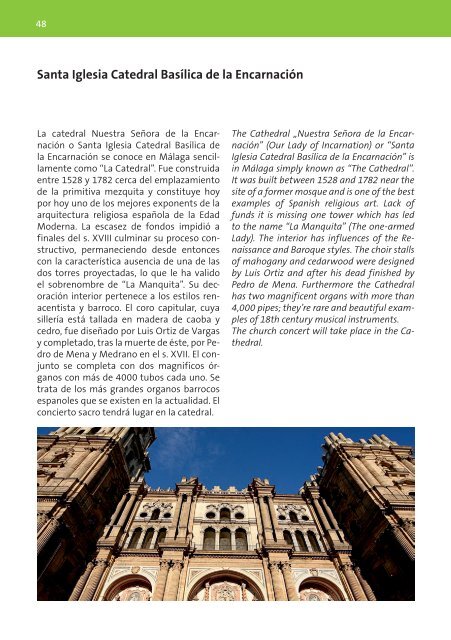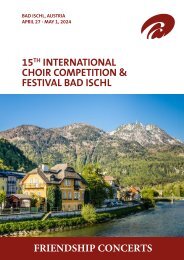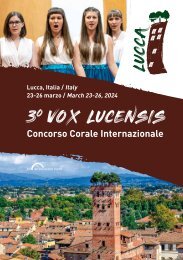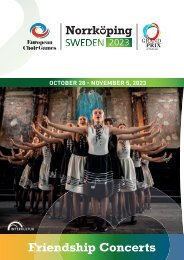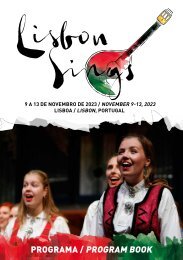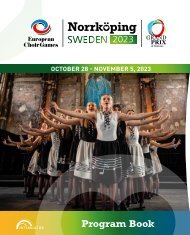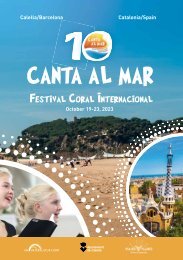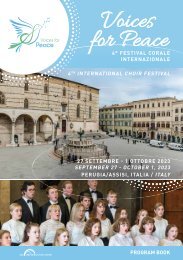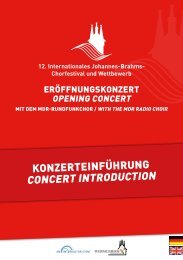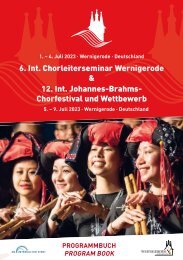Málaga 2017 - Program Book
3rd Canta en Primavera – Festival Coral Internacional April 26 - 30, 2017 Málaga, Spain Canta en Primavera – Sing in Spring! In April, when large parts of Europe are still hibernating, we present a springlike festival in one of Spain's most delightful regions. Spring in Málaga does not only stand for nature's awakening but is also symbolized by the many-voiced singing of choirs from all over the world. The Canta en Primavera - Festival Coral Internacional attracts international choirs into the Southern part of the country right to the metropolis of Málaga. Outstanding concert halls, churches and theatres will serve as ideal venues for competitions and concerts. Friendship concerts will also take place on open air stages within the heart of the Andalusian city. And as usual each choir has the possibility to select exactly those festival elements which suits its needs best: Competitions, concerts and further training. Touristic excursions to the beautiful Andalusian cities and landscapes will top this eventful activity off. http://malaga.interkultur.com
3rd Canta en Primavera – Festival Coral Internacional
April 26 - 30, 2017 Málaga, Spain
Canta en Primavera – Sing in Spring!
In April, when large parts of Europe are still hibernating, we present a springlike festival in one of Spain's most delightful regions. Spring in Málaga does not only stand for nature's awakening but is also symbolized by the many-voiced singing of choirs from all over the world.
The Canta en Primavera - Festival Coral Internacional attracts international choirs into the Southern part of the country right to the metropolis of Málaga.
Outstanding concert halls, churches and theatres will serve as ideal venues for competitions and concerts. Friendship concerts will also take place on open air stages within the heart of the Andalusian city. And as usual each choir has the possibility to select exactly those festival elements which suits its needs best: Competitions, concerts and further training. Touristic excursions to the beautiful Andalusian cities and landscapes will top this eventful activity off.
http://malaga.interkultur.com
Create successful ePaper yourself
Turn your PDF publications into a flip-book with our unique Google optimized e-Paper software.
48<br />
Santa Iglesia Catedral Basílica de la Encarnación<br />
La catedral Nuestra Señora de la Encarnación<br />
o Santa Iglesia Catedral Basílica de<br />
la Encarnación se conoce en <strong>Málaga</strong> sencillamente<br />
como “La Catedral”. Fue construida<br />
entre 1528 y 1782 cerca del emplazamiento<br />
de la primitiva mezquita y constituye hoy<br />
por hoy uno de los mejores exponents de la<br />
arquitectura religiosa española de la Edad<br />
Moderna. La escasez de fondos impidió a<br />
finales del s. XVIII culminar su proceso constructivo,<br />
permaneciendo desde entonces<br />
con la característica ausencia de una de las<br />
dos torres proyectadas, lo que le ha valido<br />
el sobrenombre de “La Manquita”. Su decoración<br />
interior pertenece a los estilos renacentista<br />
y barroco. El coro capitular, cuya<br />
sillería está tallada en madera de caoba y<br />
cedro, fue diseñado por Luis Ortiz de Vargas<br />
y completado, tras la muerte de éste, por Pedro<br />
de Mena y Medrano en el s. XVII. El conjunto<br />
se completa con dos magnificos órganos<br />
con más de 4000 tubos cada uno. Se<br />
trata de los más grandes organos barrocos<br />
espanoles que se existen en la actualidad. El<br />
concierto sacro tendrá lugar en la catedral.<br />
The Cathedral „Nuestra Señora de la Encarnación”<br />
(Our Lady of Incarnation) or “Santa<br />
Iglesia Catedral Basílica de la Encarnación” is<br />
in <strong>Málaga</strong> simply known as “The Cathedral”.<br />
It was built between 1528 and 1782 near the<br />
site of a former mosque and is one of the best<br />
examples of Spanish religious art. Lack of<br />
funds it is missing one tower which has led<br />
to the name “La Manquita” (The one-armed<br />
Lady). The interior has influences of the Renaissance<br />
and Baroque styles. The choir stalls<br />
of mahogany and cedarwood were designed<br />
by Luis Ortiz and after his dead finished by<br />
Pedro de Mena. Furthermore the Cathedral<br />
has two magnificent organs with more than<br />
4,000 pipes; they’re rare and beautiful examples<br />
of 18th century musical instruments.<br />
The church concert will take place in the Cathedral.


